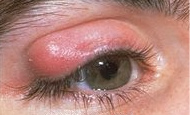|
Chalazion: Is a Common Inflammatory Mass of the Eyelids
Have you experienced chronic crusting of the eyelashes upon awakening? Have you noticed itching and burning of the eyelids as well as ocular dryness and irritation? You may be suffering from Blepharitis. A possible result of chronic Blepharitis is the development of bumps (or clogged oil glands) in the eyelids referred to as Hordeolum or Chalazion. What is a Chalazion?

It is a common inflammatory mass of the eyelids. It is marked by a reaction to the lipid (or oily) secretions of the meibomian or Zeiss glands (oil glands of the eyelids). This inflammatory reaction occurs after obstruction of the oil duct. What are signs and symptoms?
If you have a Chalazion, you will: How is it treated?
In order to view the content, you must install the Adobe Flash Player. Please click here to get started.
It is treated by two main methods. However, before treating with either of these methods, you should try hot compresses for one to two weeks, especially if you have not used heat at all to treat the original stye. Hot compresses will best be achieved by using a boiled egg wrapped by a washcloth. Of course the washcloth should be thick enough so as to not scald you but thin enough to provide continuous heat to the lesion for about 10-15 minutes twice per day. Since a it is not generally infected, antibiotics are usually not necessary. By using heat, you are attempting to save your oil gland which helps in the stability of your tear film. Follow the heat compress with digital massage (in order to rupture and express the nodule). Unfortunately, if your Chalazion has been present for a long time, the rate of success with heat goes down. Thus, if heat does not work, you will have to follow one of the following modes of treatment: An intralesional steroid injection(this option is recommended if): This method can be successful but often requires repetition: Incision and curettage of the Chalazion. Basically, this involves clamping the lesion, making a vertical incision into the lesion so as to not damage the adjacent oil glands, and scooping out the contents that pour out of the opening. What are instructions after removal?
Incision and curettage requires using antibiotic ointment in the eye and bandaging the eye for 24 hours after the procedure. You will be advised to take oral antibiotic tablets twice a day for five days and one tablet of ibuprofen 400 mg three times a day for 3 days. Antibiotic eye drops may be prescribed for 15 days. Since surgery requires bandaging for a day, resulting in loss of hours at work, and since it requires oral antibiotics for 5 days, it is a relatively more expensive option. What other recommendations can you follow for prevention?
If you do suffer from chronic Blepharitis, make sure that you manage it appropriately in order to prevent Chalazion. Using warm compresses and lid cleansing consistently will help keep your glands unclogged. If you do develop a bump on your eyelid, make sure to visit your eye care provider to get it checked. You will want to start treatment with hot compresses as described above in order to drain the clogged gland. Digital massage may help express the contents of the gland, but make sure not to massage too vigorously as you can make matters worse. Recently, botulism A toxin has been suggested as a treatment for recurrent Chalazion, but more work in this area is necessary.
|




